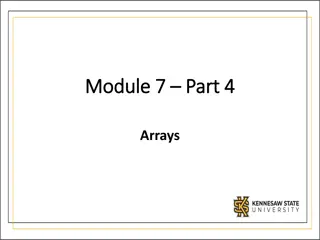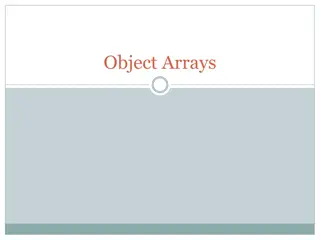Understanding Chare Arrays and Sections in Charm++
Explanation of Chare Arrays and Sections in Charm++ for parallel programming. Covers creation, motivation, section classes generation, and usage of sections in distributed systems. Discusses explicit enumeration and index range specification for section creation.
Download Presentation

Please find below an Image/Link to download the presentation.
The content on the website is provided AS IS for your information and personal use only. It may not be sold, licensed, or shared on other websites without obtaining consent from the author. Download presentation by click this link. If you encounter any issues during the download, it is possible that the publisher has removed the file from their server.
E N D
Presentation Transcript
598LVK Chare Array Sections, CkMulticast Laxmikant (Sanjay) Kale http://charm.cs.illinois.edu Parallel Programming Laboratory Department of Computer Science University of Illinois at Urbana Champaign
Chare Array Review Arbitrarily-sized collection of chares Every item in the collection has a unique index and proxy Can be indexed like an array or by an arbitrary object Can be sparse or dense Elements may be dynamically inserted and deleted Elements can be migrated 11/27/2024 cs598LVK 2
Motivation It is often convenient to define subcollections of elements within a chare array Example: rows or columns of a 2D chare array One may wish to perform collective operations on the subcollection (e.g. broadcast, reduction) Sections are the standard subcollection construct in Charm++ 11/27/2024 cs598LVK 3
Section Creation Through explicit enumeration: CkVec<CkArrayIndex3D> elems; // add array indices for (int i=0; i<10; i++) for (int j=0; j<20; j+=2) for (int k=0; k<30; k+=2) elems.push_back(CkArrayIndex3D(i, j, k)); CProxySection_Hello proxy = CProxySection_Hello::ckNew(helloArrayID, elems.getVec(), elems.size()); 11/27/2024 cs598LVK 4
Section Creation Through index range specification: CProxySection_Hello proxy = CProxySection_Hello::ckNew(helloArrayID, 0, 9, 1, 0, 19, 2, 0, 29, 2); 11/27/2024 cs598LVK 5
Section Class Generation Section proxy classes are automatically generated for each chare and group defined in the ci file Placed into decl.h and def.h files Take a look at the CProxySection classes and their member functions in the decl.h and def.h for your MPs 11/27/2024 cs598LVK 6
Using Sections CProxySection_Hello proxy; // section broadcast proxy.someEntry(...) // send to the first element in the section proxy[0].someEntry(...) 11/27/2024 cs598LVK 7
CkMulticast Charm++ library for high performance broadcasts and reductions over sections # compile and install the CkMulticast library cd charm/tmp make multicast # link CkMulticast library using -module charmc -o hello hello.o -module CkMulticast -language charm++ 11/27/2024 cs598LVK 8
Delegation A way to customize Charm++ send and receive behavior CkDelegateMgr interface class with virtual functions for sending messages to chares, groups, nodegroups, arrays, sections Delegation Manager Any group which inherits from CkDelegateMgr Specifies communication behavior by overriding one or more of the default communication functions 11/27/2024 cs598LVK 9
Delegation Achieved by associating a delegation manager to a proxy Different proxies for the same array or section may be associated with different delegation managers with distinct implementations of communication functions 11/27/2024 cs598LVK 10
CkMulticastMgr A delegation manager which implements section broadcasts and reductions Overrides CkDelegateMgr::ArraySectionSend CProxySection_Hello sectProxy = CProxySection_Hello::ckNew(...); CkGroupID mCastGrpId = CProxy_CkMulticastMgr::ckNew(); CkMulticastMgr *mCastGrp = CProxy_CkMulticastMgr(mCastGrpId).ckLocalBranch(); // initialize section proxy sectProxy.ckSectionDelegate(mCastGrp); //multicast via delegation library as before sectProxy.someEntry(...); 11/27/2024 cs598LVK 11
Spanning Trees CkMulticast implements tree algorithms for multicasts and reductions Messages are routed over a spanning tree of the section elements Default branching factor is 2 Modifying branching factor: CkGroupID mCastGrpId = CProxy_CkMulticastMgr::ckNew(3); // factor is 3 11/27/2024 cs598LVK 12
CkMulticast Messages To use CkMulticast library, all multicast messages must inherit from CkMcastBaseMsg CkMcastBaseMsg must be inherited from first No parameter marshalling is allowed in entry methods used as targets of multicast class HiMsg : public CkMcastBaseMsg, public CMessage_HiMsg { public: int *data; }; 11/27/2024 cs598LVK 13
Reductions: CkSectionInfo An array element can be a member of multiple array sections It is necessary to disambiguate which array section reduction it is participating in each time it contributes to one A data structure called ''CkSectionInfo'' is created by CkMulticastMgr for each array section that the array element belongs to During a section reduction, the array element must pass the CkSectionInfo as a parameter in the contribute() 11/27/2024 cs598LVK 14
Reductions with CkMulticast CkSectionInfo cookie; void SayHi(HiMsg *msg) { // update section cookie every time CkGetSectionInfo(cookie, msg); int data = thisIndex; mcastGrp->contribute(sizeof(int), &data, CkReduction::sum_int, cookie); } 11/27/2024 cs598LVK 15
Callbacks As with array reductions, a callback needs to be specified with each contribute OR a default callback should be specified using setReductionClient 11/27/2024 cs598LVK 16
Example: Matrix Multiplication Inputs: 2D chare arrays A, B of matrix blocks Output: 2D chare array C of matrix blocks Elements of A and B multicast their blocks to a section comprising a row or column of C Exercise: implement algorithm 11/27/2024 cs598LVK 17
Example: LeanMD Lennart-Jones Dynamics (Lecture on 9/18) Remember we had a 3D array of Cells And a 6D array of 11/27/2024 cs598LVK 18
Object Based Parallelization for MD: Force Decomposition + Spatial Decomposition Now, we have many objects to load balance: Each diamond can be assigned to any proc. Number of diamonds (3D): 14 Number of Patches 2-away variation: Half-size cubes 5x5x5 interactions 3-away interactions: 7x7x7
Parallelization Using Charm++ The computation is decomposed into natural objects of the application, which are assigned to processors by Charm++ RTS
Expressing in Charm++ Two chare arrays: Cells: a 3D array of chares Pairs: one object for each neighboring chare What is the dimensionality of pairs ? Idea 1: make it a 3D array.. Does it work? Idea 2: Make it a 1D array, Explicitly assign indices to chares: the pair object between Cells[2,3,4] and Cells[2,3,5] is Pairs[someIndex]. Idea 3: Make it a 6D array Pairs[2,3,4,2,3,5] But: (a) it is sparse and (b) symmetry? Do we also have Pairs[2,3,5,2,3,4] Use only one of them.. (say smaller in dictionary order)
LJdynamics - Cell entry void run() { for(stepCount = 1; stepCount <= finalStepCount; stepCount++) { int n) neighbors atomic { atomic { sendPositions() for(forceCount=0; forceCount < inbrs; forceCount++) when receiveForces[stepCount](int iter, vec3 forces[n], sendPositions(); } if ((stepCount % MIGRATE_STEPCOUNT) == 0) { atomic { updateProperties(); } atomic { addForces(forces); } atomic { sendParticles(); } when statements for receiving particles from } } contribute(0, CkReduction::NULL, CkCallback(CkReductionTarget(Main,done),mainProxy)); }
LJdynamics - Pair entry void run() { for(stepCount = 1; stepCount <= finalStepCount; stepCount++) { if ( thisIndex.x1==thisIndex.x2 && thisIndex.y1==thisIndex.y2 && thisIndex.z1==thisIndex.z2) when calculateForces[stepCount](ParticleData *data) atomic { selfInteract(data); } else { when calculateForces[stepCount] (ParticleData *data) atomic { bufferedData = data; } when calculateForces[stepCount](ParticleData *data) atomic { interact(data); } } } };
Using section in sendPositions Especially useful if you are using a 2-away formulation: There are 5x5x5 = 125 pairs to which each cell must send its coordinates Same data to everyone, so it is a Multicast This happens repeatedly, every iteration At load balancing time the locations of pairs may change, but the set is the same So, each cell sets up its own section of pairs Each pair is a member of two [or one] sections 11/27/2024 cs598LVK 24























